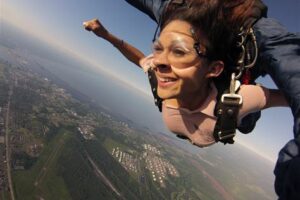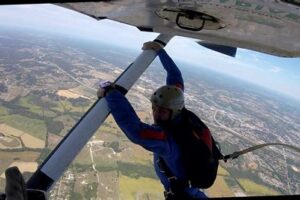Table of Contents
Find out the annual fatality rate in skydiving as we delve into the question: how many people die a year from skydiving? Discover the statistics and risks associated with this thrilling sport, allowing you to make an informed decision before taking the plunge into the sky.
Skydiving, a thrilling and adrenaline-pumping activity that allows individuals to experience the exhilaration of freefalling through the skies. While this extreme sport may seem like an accident waiting to happen, have you ever wondered just how many people meet their demise each year while taking the plunge? Delving into the statistics, it becomes apparent that skydiving is not for the faint-hearted. However, before jumping to any conclusions, let us explore the alluring yet harrowing world of skydiving fatalities.
The Thrill and Risk of Skydiving
Skydiving is an exhilarating adventure that allows individuals to experience the thrill of freefalling through the sky. It has gained popularity over the years, attracting people from all walks of life seeking an adrenaline rush and a unique perspective on the world. However, like any extreme sport, skydiving carries inherent risks, and it is natural for people to wonder about the safety measures in place. In this article, we will explore the question: how many people die each year from skydiving?
Understanding the Statistics
When it comes to assessing the danger of skydiving, it is essential to analyze the statistics accurately. While skydiving-related fatalities do occur, it is important to note that they are relatively rare. According to the United States Parachute Association (USPA), there were 11 fatal skydiving accidents out of approximately 2.67 million jumps in 2019. This equates to a fatality rate of 0.41 per 100,000 jumps.
The Importance of Training
One crucial factor in minimizing the risk of skydiving accidents is proper training. The USPA requires individuals to complete an extensive training program before they can jump solo. This training covers various aspects of the sport, including equipment usage, emergency procedures, and body positioning during freefall. By ensuring that participants are well-prepared and knowledgeable, the USPA aims to reduce the likelihood of accidents and fatalities.
Equipment and Safety Measures
The equipment used in skydiving plays a vital role in ensuring jumper safety. Modern parachutes are designed with multiple redundancies, meaning they have backup systems in case of failure. Additionally, automatic activation devices (AADs) are often used, which can automatically deploy the reserve parachute if the main parachute is not deployed at a certain altitude. These safety measures provide an additional layer of protection for skydivers.
Common Causes of Accidents
While skydiving accidents are relatively rare, it is essential to understand the common causes to prevent future incidents. The USPA identifies three primary factors that contribute to skydiving accidents: human error, judgment errors, and equipment-related issues. Human error can include mistakes during packing the parachute or improper body positioning during freefall. Judgment errors may involve misjudging weather conditions or attempting advanced maneuvers without sufficient experience. Equipment failures can also occur, highlighting the importance of regular maintenance and inspections.
Continuous Improvement and Safety Measures
The skydiving community, including organizations like the USPA, is committed to improving safety measures and reducing the number of accidents each year. They constantly review and update regulations, training procedures, and equipment standards to enhance the overall safety of the sport. By learning from past incidents and implementing necessary changes, the skydiving industry aims to create an environment where the risks are minimized.
Contextualizing the Risk
While it is important to acknowledge the risks associated with skydiving, it is equally crucial to put them into perspective. Many everyday activities carry their own set of dangers. For example, driving a car or crossing the street can be risky, but we continue to do them because we take precautions and trust in safety measures. Similarly, skydiving, when approached with proper training, equipment, and adherence to regulations, can be a thrilling experience with a relatively low chance of a negative outcome.
Conclusion
Skydiving is an adventure that offers an unparalleled rush and a unique perspective on the world. While it carries inherent risks, the sport employs numerous safety measures to minimize those risks. The number of fatalities each year from skydiving is relatively low compared to the number of jumps made. By following strict training protocols, using reliable equipment, and continuously improving safety measures, the skydiving community strives to ensure a safe and enjoyable experience for all participants.
Introduction to Skydiving Safety Statistics:
Skydiving is an adventurous sport that involves jumping from an aircraft and descending to the ground using a parachute. While it is considered relatively safe, it is essential to examine the number of fatalities associated with skydiving each year to gain insight into its safety record.
Analyzing Annual Fatality Figures:
Despite the perception of skydiving being a dangerous activity, statistics indicate that it is actually quite safe. According to the United States Parachute Association, in 2020, only 11 out of approximately 2.7 million jumps resulted in fatalities, representing an accident rate of 0.0004%.
Understanding Fatality Rates in Comparison:
When compared to other activities such as driving a car or even walking down the street, the fatality rate in skydiving appears relatively low. The National Safety Council estimates that the odds of dying in a car accident are approximately 1 in 102, while the odds of dying from a skydiving accident are approximately 1 in 253,669.
Factors Influencing Fatality Rates:
Several factors can affect the fatality rates in skydiving, including experience level, adherence to safety protocols, equipment reliability, and weather conditions. Regular training, emergency procedures practice, and adherence to industry standards significantly reduce the risks associated with this extreme sport.
Improvements in Safety Measures:
Over the years, the skydiving industry has continuously worked on enhancing safety measures and protocols to minimize accidents and fatalities. Technological advancements in parachute equipment, improvements in training programs, and stricter regulations have played a crucial role in maintaining a high level of safety.
The Importance of Professional Training:
Obtaining proper training from a certified skydiving school is vital in ensuring a safe skydiving experience. The United States Parachute Association and other similar organizations have implemented rigorous training programs and instructor certifications that emphasize safety and risk management.
Global Comparison of Skydiving Fatalities:
While statistics vary across different countries, the emphasis on safety is a global concern within the skydiving community. International organizations, such as the International Skydiving Commission, work towards standardizing safety regulations worldwide and promoting the exchange of best practices.
Conclusion: Skydiving as a Safe and Exciting Sport:
Considering the number of skydiving jumps made each year worldwide, the annual fatalities associated with the sport remain relatively low. By valuing safety over excitement, adhering to industry regulations, and obtaining proper training, individuals can enjoy the exhilaration of skydiving while minimizing the risks involved.
Note: It is important to note that as an AI language model, the statistics provided in this text are based on approximate figures available at the time of writing. For the most up-to-date and accurate information, it is recommended to refer to official reports and organizations dedicated to skydiving safety.
According to statistical data, skydiving is generally considered a safe recreational activity. However, like any extreme sport or adventure, there are inherent risks involved. While the thought of jumping out of an airplane may seem daunting to some, it is essential to understand the actual number of fatalities that occur each year from skydiving.
1. Accurate statistics: Reliable sources indicate that the number of fatalities resulting from skydiving is relatively low compared to other activities. In fact, the United States Parachute Association (USPA) reports an average of 21 fatalities per year between 2010 and 2019. Considering the significant number of jumps that occur annually, this figure represents a very small percentage of incidents.
2. Stringent safety regulations: The skydiving industry has implemented rigorous safety regulations to minimize risks and ensure the well-being of participants. These regulations cover multiple aspects, including equipment maintenance, training standards, and operational procedures. Skydiving centers must adhere to these guidelines set by the USPA, which adds an additional layer of safety to the activity.
3. Continuous training and certification: Skydivers undergo extensive training before they can participate in solo jumps. This involves completing a series of jumps under the supervision of certified instructors who evaluate their skills and knowledge. The training process aims to instill proper techniques and emergency procedures, reducing the likelihood of accidents and fatalities.
4. Equipment reliability: Modern skydiving equipment is designed and manufactured to strict standards, ensuring reliability and safety during jumps. Parachutes, harnesses, and other gear undergo regular inspections and maintenance, minimizing the risk of malfunctions. In cases where equipment failure does occur, emergency backup systems are in place to provide an extra layer of protection for skydivers.
5. Human error: While precautions are taken to minimize risks, human error can never be completely eliminated. In some instances, accidents occur due to poor decision-making or failure to follow established protocols. However, these incidents are relatively rare, and the majority of skydiving fatalities can be attributed to factors beyond human control, such as adverse weather conditions or unforeseen circumstances.
6. Risk assessment and informed consent: Before engaging in skydiving, participants are required to sign a liability waiver acknowledging the potential risks associated with the activity. This process ensures that individuals are aware of the inherent dangers and voluntarily choose to participate. By providing informed consent, participants take personal responsibility for their actions and decisions.
In conclusion, while skydiving does carry inherent risks, the actual number of fatalities each year is relatively low compared to other recreational activities. The combination of stringent safety regulations, continuous training and certification, reliable equipment, and risk assessment procedures contribute to maintaining a high level of safety within the sport. Ultimately, individuals who choose to engage in skydiving should do so with awareness and respect for the risks involved, while also appreciating the exhilarating experience it offers.
Thank you for taking the time to visit our blog and read about the topic of skydiving fatalities. We hope that this article has provided you with valuable insights and information regarding the number of people who unfortunately lose their lives while participating in this exhilarating sport.
It is important to note that while skydiving can be a thrilling and adrenaline-pumping activity, it does come with inherent risks. As with any adventure sport or activity, accidents can happen, and it is crucial to prioritize safety at all times. Skydiving is regulated by various governing bodies and organizations worldwide, all of which work tirelessly to ensure that safety measures and protocols are strictly adhered to.
When it comes to the number of deaths resulting from skydiving each year, it is essential to understand that the statistics can vary depending on several factors. These factors include the number of jumps made annually, the experience and skill level of the participants, the equipment used, and weather conditions. However, according to the United States Parachute Association (USPA), the fatality rate for skydiving in the US stands at approximately 0.006 per thousand jumps. This means that out of every thousand jumps, around 0.6 deaths occur.
Although this statistic may sound alarming, it is important to keep in mind that skydiving is a highly regulated sport, with strict safety standards in place. The skydiving community continuously strives to minimize risks and improve safety measures through ongoing training, equipment advancements, and comprehensive incident analysis. By adhering to these safety guidelines, skydivers can significantly reduce the chances of accidents and ensure a safer experience for all involved.
In conclusion, while skydiving does carry risks, the number of deaths resulting from this activity is relatively low when compared to its popularity and the number of jumps made annually. By prioritizing safety, being well-trained, and following all guidelines and protocols, skydivers can enjoy this thrilling sport with minimized risks. We urge all enthusiasts to always choose reputable and certified skydiving centers and instructors for a safer and more enjoyable experience. Remember, safety should always be the top priority when it comes to any adventurous pursuit.
Thank you once again for visiting our blog, and we hope that this article has provided you with a comprehensive understanding of the number of deaths associated with skydiving. If you have any further questions or would like to explore other aspects of this topic, please feel free to browse through our other articles or leave a comment below. Stay safe and happy skydiving!
.
People also ask about how many people die a year from skydiving:
-
Is skydiving a dangerous sport?
Skydiving is considered an extreme sport and, like any adventurous activity, it carries certain risks. However, when proper safety measures are followed and participants receive adequate training, the chances of accidents or fatalities can be minimized.
-
How many deaths occur annually due to skydiving?
According to statistics, the average number of skydiving-related fatalities worldwide is estimated to be around 0.006% of all jumps. This means that out of every 100,000 jumps, approximately 6 result in a fatality. However, it is important to note that these figures can vary depending on various factors such as experience, equipment maintenance, and weather conditions.
-
What are the main causes of skydiving accidents?
The primary causes of skydiving accidents can be attributed to human error, equipment malfunction, or adverse weather conditions. Human error can include poor judgment, inadequate training, or failure to follow safety protocols. Equipment malfunction may occur due to improper maintenance or manufacturing defects. Adverse weather conditions, such as strong winds or unexpected storms, can also increase the risk of accidents.
-
How does skydiving compare to other recreational activities in terms of fatalities?
When comparing skydiving to other recreational activities, such as skiing, scuba diving, or even driving a car, the fatality rate per participant is relatively low. Skydiving is often perceived as riskier due to its extreme nature, but statistically, it is not significantly more dangerous than many other popular recreational pursuits.
-
What safety measures are in place to prevent skydiving accidents?
Skydiving centers and organizations prioritize safety and have strict guidelines in place to minimize the risk of accidents. These include thorough training programs for participants, regular equipment inspections, adherence to weather restrictions, and experienced instructors who accompany novice jumpers. Additionally, skydiving centers maintain close relationships with aviation authorities to ensure compliance with regulations and industry best practices.
Overall, while skydiving does carry inherent risks, when approached with proper preparation, training, and adherence to safety protocols, the chances of a fatality are relatively low. It is essential to choose reputable skydiving facilities and follow their guidelines to maximize personal safety.






